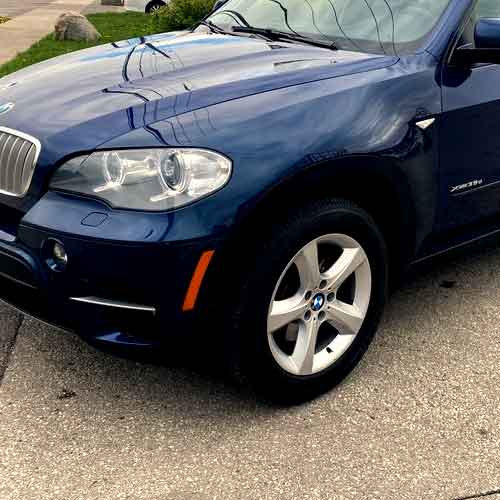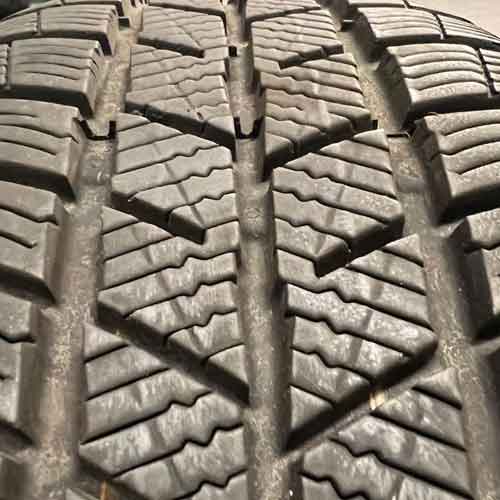In the winter tire spectrum, the Barum Polaris 5 and the Continental WinterContact TS860 stand tall with their impressive performance credentials. But which of the two stands the test of winter roads better? Let’s find out!

Table of Contents
Key Takeaway
- Wet Performance: WinterContact outperforms its counterpart due to versatile siping design, improving grip on damp surfaces. Its peer, however, exhibits less aggressive siping with a stiffer rubber compound, affecting performance.
- Snow Grip: Barum Polaris 5 (review) takes the lead in light snow due to its effective tread design, capturing snow and ensuring better contact.
- Vibration Dampening: The Continetal shines in absorbing road disturbances, offering a smoother ride. On the flip side, its counterpart provides a stiffer ride due to a harder rubber compound.
- Noise Generation: The Barum wins with superior pitch sequencing technology that reduces overall noise, while its counterpart experiences higher in-groove resonance levels, so it becomes noisier.
- Ice Traction: WinterContact leads, providing faster braking and handling on icy surfaces, while its counterpart lags due to fewer ice-biting features.
- Dry Gripping: Both tires perform similarly, but Barum 5 slightly edges out if one can tolerate road stiffness.
- Dry Handling: Polaris 5 outperforms the other with superior lateral g-forces and lap times.
- Tread and Fuel Usage: The Continental WinterContact is more fuel-efficient due to streamlined lugs and less aggressive tread voids. Whereas the Polaris 5, exhibits longer tread life thanks to a tougher rubber compound and deeper tread.
Snow Grip
When it comes to snowy conditions, the Barum Polaris 5 takes the lead, particularly when navigating light and fluffy snow.
Though it should be noted, however, that its performance falls short on icy or compacted snow, which will be discussed separately.
So the Barum Polaris 5’s superior performance in snow can be attributed to its tread design, which features abundant in-groove notches and voids.

These design elements act as snow trappers, enhancing ground contact by capturing the snow.
Basically what’s happening here is that the tire is utilizing the snow sticking effect to its advantage.
You see, snow has better adherence to itself than to rubber, contributing to the tire’s excellent performance.
So with lodged snow, the tire is making better contact, and yielding superior results.
On the other hand, the Continental WinterContact TS860, with its less spacious and simpler tread design, fails to offer as effective snow-to-snow contact, especially in heavier conditions.
Wet Performance
When it comes to wet surfaces, the performance of tires heavily depends on their design features. One crucial factor is the number of grooves or sipes present on the tire, as well as the ability of the tread rubber to absorb water.
Both of these go hand in hand, as sipes basically suck water particles in (by flexing), and so they need to be malleable, to properly contract or expand.
Having said that, although both tires feature ample grooves and sipes to displace water and prevent, slipping and hydroplaning, I would still go with Continental WinterContact here.
This is because this tire
incorporates diverse types of sipes that are adept at absorbing and channeling water, thus enhancing its grip on damp roads.
The tire’s design includes numerous tightly-packed, sturdy yet flexible sipes, which greatly bolster its performance around corners.
On the other hand, the Barum Polaris 5, while not lagging too far behind, exhibits less aggressive siping and a stiffer rubber compound.
So it’s sipes aren’t giving us as great of the overall handling and braking capabilities.
Road Vibrations Dampening
Tires play a vital role in dampening road irregularities and act as supplementary suspension systems for the vehicle, if you will.
And to cut the story short, in that aspect, the Continental WinterContact takes the lead with its superior, and innovative tread compound.
Its rubber basically offers a better managing of uneven surfaces, absorbing road disturbances, and resulting in a relatively more smoother ride for the driver and passengers.
Whereas on Barum, you don’t see as much bumps absorption, and it makes sense, as the tire offers a comparatively stiffer rubber compound (to basically improve tread life).
Ice Traction
When it comes to traction on ice-clad surfaces, the WinterContact TS860 shines, thanks to its angled slits and multi-directional in-groove notches.
These combined with the tread’s robust siping, facilitate faster braking and enhanced handling on icy surfaces, allowing for 2 seconds faster handling times, and 4 feet shorter braking.
So why the Barum Polaris 5 is lagging here?
Well mainly due to the wider tread gaps, limited notches, and less aggressive siping pattern, resulting in fewer “teeth” biting into the ice.
Therefore, the winner in terms of ice traction is the Continental.
Noise Generation
Tire noise primarily originates from two sources: air colliding with the tread walls, mainly entering through shoulder voids, and in-groove resonance caused by echoing noise within the tread.
And Continental here, is taking the back seat. Basically the tire’s shoulder voids restrict a lot of air entry, reducing noise from that source (as that’s where most air come in). But the problem emerges from within, as that noise echo more, creating higher in-groove resonance levels.
In contrast, the Barum Polaris 5 manages to be quieter, thanks to its superior pitch sequencing technology.
This technology modifies the tread block geometry, causing various tones to be produced as air particles collide with the tread.
And then, these different tones then work to cancel each other out, resulting in reduced overall noise.
Tread and Fuel Usage
The relationship between tread life and fuel economy primarily depends on rolling resistance, which is significantly influenced by the tire’s weight, tread composition, and design.
In terms of fuel efficiency, the Continental WinterContact TS860 emerges superior, with its more streamlined lugs and less aggressive tread voids.
This design minimizes obstacles during linear rolling and enhances fuel economy.
However, when considering tread life, the Barum excels, due to its harder tread compound and deeper tread.
The Barum Polaris 5 basically, resists wear more effectively, thanks to its lighter weight and tougher rubber compound.
And of course, its deeper tread also implies a longer duration to reach the legally required 2/32″ tread depth, extending its lifespan.
So in essence, the Continental is better in fuel (though only marginally), while the Barum does better in case of treadwear. Though both tires don’t offer any warranty, if you are wondering.
Dry Gripping
The effectiveness of dry grip depends predominantly on the central tread area, where the majority of the tire’s load is concentrated during linear cruising.
And so it makes sense why both tires are on par here. Showing up with similar braking distance values.
Though if you still have to pick one. Go with Barum, if you don’t mind the road stiffness, otherwise Continental should be considered.
Though note that its only half part of the overall equation, and the other, handling, can be a deal-breaker for you if you consider Wintercontact (for dry road, of course).
Dry Handling
The tire’s ability to handle or maintain lateral grip depends largely on the shoulder lug design and overall tread “flexibility”.
Now the thing both tires offer very closed up shoulder lugs, but still you see superior lateral g-forces and lap times on Barum.
This is because the WinterContact has a softer rubber which flex/bend more as the tire corners, this results in lagging steering response, and greater susceptibility to oversteering and understeering.
Take Home Points
This rigorous comparison has highlighted the strengths of both tires, with each outperforming the other in different categories.
The Continental WinterContact TS860 excels in wet traction, vibration dampening, and ice performance. On the other hand, the Barum Polaris 5 dominates in snow performance, noise reduction, and dry traction. Interestingly, both tires present stiff competition in dry handling.
Moreover, while the Continental’s boy also excels in fuel economy, the Barum Polaris takes the prize for tread life.